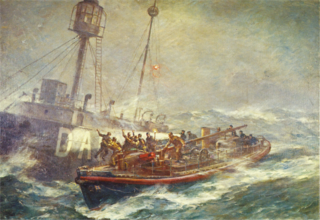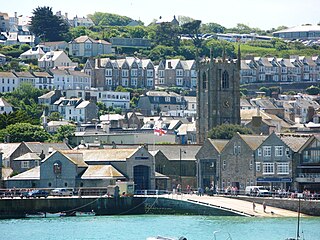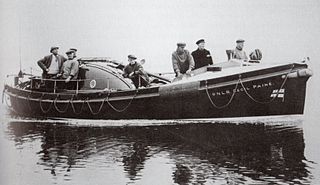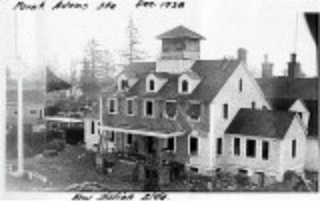Related Research Articles

Henry George Blogg GC BEM was a lifeboatman from Cromer on the north coast of Norfolk, England and the most decorated in RNLI history.
RNLB Mona was a Watson-Class lifeboat based at Broughty Ferry in Scotland, that capsized during a rescue attempt, with the loss of her entire crew of eight men. The Mona was built in 1935, and, in her time, saved 118 lives.

Padstow Lifeboat Station is at Trevose Head west of Padstow. The current lifeboat is a Tamar class boat called Spirit of Padstow.

Walmer Lifeboat Station was established in 1830. Over two thousand ships are believed to have been wrecked on the Goodwin Sands, and the masts of several wrecks are visible from the shore at low tide. Hence there have always been two lifeboats located at the joined towns of Deal and Walmer along the coast opposite the sands.

The SS Mount Ida was a cargo ship built in 1938 by William Hamilton & Co. Ltd of Glasgow. Launched in 1938 as Arcscott, she was renamed Mount Ida after being bought by the Atlanticos Steam Ship Company Ltd, of Athens, Greece. She was wrecked in 1939 after being in service for only about 18 months.

RNLB Louisa Heartwell was the sixth lifeboat to be stationed at Cromer on the coast of the English county of Norfolk She was launched from the beach station and was on station from 1902 to 1932. During her period on station at Cromer the Louisa Heartwell had only two coxswains during her 29-year career. The coxswains were Matthew James Buttons Harrison until his retirement in 1909, and then Henry George Blogg.

RNLB Mary Stanford was the Ballycotton Lifeboat from 1930 to 1959. Ballycotton is on Ireland's southern coast, a trade route to the Americas. There are many dangerous rocks and shallows with on-shore prevailing winds. Ballycotton has a long tradition of life-saving. Mary Stanford had 41 "shouts" and saved 122 lives. She performed the notable Daunt Lightship rescue on 11 February 1936. After her withdrawal from service she lay for some years in a backwater of Dublin's Grand Canal Dock, but has now been returned to Ballycotton for restoration.
SS Gallois was one of seven merchant vessels which became stranded and then wrecked on Haisbro Sands of the Norfolk coast on 6 August 1941 during the Second World War. The SS Gallois had been part of a convoy with the designation Convoy FS 559.

St Ives Lifeboat Station is the base for Royal National Lifeboat Institution (RNLI) search and rescue operations at St Ives, Cornwall in the United Kingdom. The first lifeboat was built for the town in 1840 and the present boathouse was opened in 1994. It operates a Shannon-class all weather boat (AWB) and a D-class (IB1) inshore lifeboat (ILB).

Salcombe Lifeboat Station is the base for Royal National Lifeboat Institution (RNLI) search and rescue operations at Salcombe, Devon in England. The first lifeboat was stationed in the town in 1869. The Salcombe Lifeboat has twice capsized, in 1916 with the loss of 13 lives, and in 1983 with no loss of life. Since 2008 the station has operated a Tamar-class all weather boat (ALB) and an Atlantic 75 inshore lifeboat (ILB).

Torbay Lifeboat Station is the base for Royal National Lifeboat Institution (RNLI) search and rescue operations at Brixham, Devon in England. Brixham Lifeboat Station was opened in 1866 but since 1924 it has been known as 'Torbay'. Since 2005 it has operated a Severn-class all-weather lifeboat (ALB) together with a D-class (IB1) inshore lifeboat (ILB).

RNLB Foresters Centenary is a retired Liverpool-class lifeboat of the Royal National Lifeboat Institution. that was stationed in the English coastal town of Sheringham in the county of Norfolk in the United Kingdom. The lifeboat was on station for 25 years between 1936 and 1961 when she was sold. She has been restored to her original condition and is exhibited in Sheringham Museum.

RNLB Cecil Paine is a retired Liverpool-class non-self-righting lifeboat of the Royal National Lifeboat Institution. It was the second motor lifeboat to be stationed in the English coastal town of Wells-next-the-Sea in the county of Norfolk in the United Kingdom, and was on station at Wells from 25 July 1945 until she was sold in June 1965.

Henry Ramey Upcher was the second private lifeboat to be stationed in the English town of Sheringham in the county of Norfolk She was launched on 4 September 1894 and stayed on station for 41 years until she was slowly retired from duty and by 1935 had ceased rescue work completely. The Lifeboat is now on permanent display in her own museum housed in her converted original boat shed.

RNLB Emma Constance was a Barnett-class lifeboat stationed at Aberdeen Lifeboat Station, in the Scottish city of Aberdeen from 1927 until August 1951. The lifeboat was designed by James R. Barnett who was a consulting naval architect to the Royal National Lifeboat Institution.

Skegness Lifeboat Station is an RNLI operated lifeboat station located in the town of Skegness in the English county of Lincolnshire. The station is located on the south-east coast north of the Wash and south of the Humber Estuary. This area of the British coastline is characterised by many shoals and constantly changing sandbanks, many of which lie between the town and the East Dudgeon Lightship. The current station was built in 1990 and was the first in the British Isles built especially to house a Mersey-class lifeboat. The boathouse also accommodates an Inshore Lifeboat and a souvenir shop.

Aberystwyth Lifeboat Station is an RNLI lifeboat station in the coastal resort of Aberystwyth, Ceredigion, West Wales. It was established in 1861, but there has been a lifeboat serving the town since 1843.
SS Stolwijk, a Dutch cargo ship of 2,489 tons, was wrecked off the coast of Donegal on 6 December 1940. She was part of a Convoy SC 13 sailing from the Dominion of Newfoundland to Liverpool, England, when her rudder was damaged in a fierce storm. Attempts to rescue her by her destroyer escort failed and she went on the rocks off Tory Island, County Donegal, Ireland. Ten of her crew were lost but the remaining 18 were rescued the following day by Arranmore Lifeboat and landed safely in Burtonport. The rescue of the survivors was conducted in terrible weather conditions and both the RNLI and Queen Wilhelmina of the Netherlands awarded medals to the Irish lifeboat crew.

Coast Guard Station Point Adams was a United States Coast Guard base at the mouth of the Columbia River. It was founded in 1888, by the United States Lifesaving Service, one of the service that were amalgamated into the Coast Guard.

Same ship as the troop ship U.S.A.T. Rosecrans
References
- 1 2 Stephen Wood (2016-05-16). "Park Happenings: The U.S. Life-Saving Service, and the shipwreck Rosecrans". Chinook Observer . Retrieved 2017-12-16.
On Jan. 7, 1913, the steamship Rosecrans ran aground on Peacock Spit at the mouth of the Columbia River.
- 1 2 3 4 5 Douglas Kroll (2014-09-15). A Coast Guardsman's History of the U.S. Coast Guard. Naval Institute Press. ISBN 9781612518763 . Retrieved 2017-12-16.
- ↑ "Account of the wreck of the Rosecrans taken from the 1913 Annual Report of United States Life-saving Service, 66-74" (PDF). United States Life-saving service . 1913. Retrieved 2018-01-04.
- ↑ Edward Stratton (2016-05-16). "A Hollywood ending for daring surfmen". Daily Astorian . Long Beach, Washington . Retrieved 2017-12-16.
The Rosecrans grounded on Peacock Spit, a shoal at the entrance to the Columbia, on Jan. 7, 1913. After grounding, the ship made three or four S.O.S calls, before the captain ordered them halted, fearful sparks would start a fire on board. The Rosecrans did not blow its whistle, either, and it took several hours for rescuers to find the ship in the bad weather.
- ↑ Finn J.D. John (2015-06-21). "Cursed or not, S.S. Rosecrans". Offbeat Oregon . Retrieved 2017-12-16.
- ↑ "1909 US Life Saving Service Boat Donated to the conservancy". Michigan Lifeboat Conservancy. 2005. Retrieved 2018-01-04.